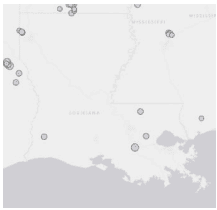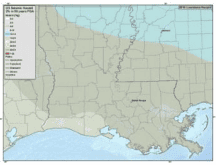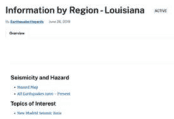Earthquake
Data Limitations
Globally, scientific understanding of earthquake processes is somewhat limited, and the available history of seismicity is typically too short to establish reliable spatiotemporal patterns of large earthquake occurrences (Stein et al. 2012).
Definition and Description
A sudden slip on a fault, with resulting ground shaking and radiated seismic energy caused by the slip, or by volcanic or magmatic activity, or other sudden stress changes in the earth (USGS 2018).
Earthquakes occur from the sudden release of stress in the Earth’s crust. Stress is built up by the motion of tectonic plates. Stress may also be built up through the injection of fluids. During an earthquake, rocks on either side of a fault line move either horizontally or vertically. This movement creates three types of waves: primary, secondary and rayleigh waves. Primary waves spread outward from the epicenter (source of the fracture) as compression, like a spring. Secondary waves vibrate at right angles to the direction of travel, and these are the most damaging. Rayleigh, or surface, waves move vertically, giving an undulating motion. Earthquake intensity is measured on the Moment Magnitude Scale. Each point represents a 10-fold increase in the wave amplitude and a 32-times increase in energy release.
Most earthquakes that occur in Louisiana are small in magnitude and cause minor damage. An earthquake caused by the New Madrid fault, situated in the Mississippi Valley, could impact Louisiana.
Historical Data
Earthquake Catalog
(Period of record varies by location; up to ~90 years)U.S. Geological SurveyThis tool shows past earthquakes on an interactive map and can be used to show previous occurrences.
1. Under Basic Options, select the Magnitude, Date and Time, and Geographic Region to plot. Choose a Custom date and time with a start date such as “1970-01-01 00:00:00” to view long-term trends. Select a Custom Geographic Region for Louisiana by clicking Custom, then zooming into the pop-up map and drawing a rectangle around Louisiana. 2. Click Search. 3. A map with all earthquakes meeting your chosen criteria are shown and a list of earthquakes are on the left of the page. 4. View the map legend by clicking the key icon on the top right of the map area. To learn more about specific events, click any point on the map or select an event from the list. You can also sort by date or magnitude.
2014 Seismic Hazard Map
U.S. Geological SurveyThis map from 2014 shows the seismic hazards in Louisiana. Louisiana has a low seismicity risk.
Louisiana Earthquake Information Page
U.S. Geological SurveyAdditional information about earthquakes in Louisiana can be found on this page. Click on links of interest.
Climate Change Trends
Louisiana has a low seismicity risk, and the U.S. Geological Survey has only recorded 5 earthquakes since 2000. The earthquakes that have occurred were low in magnitude and caused minimal damage. The New Madrid seismic zone poses a potential threat to Louisiana, which impacted Louisiana and areas in the central and eastern U.S. in the early 1800s (Stevenson and McCulloh 2001). Note: this section of the Simple Planning Tool is titled ‘Climate Change Trends’, but in the case of earthquakes please regard this as future trends.



